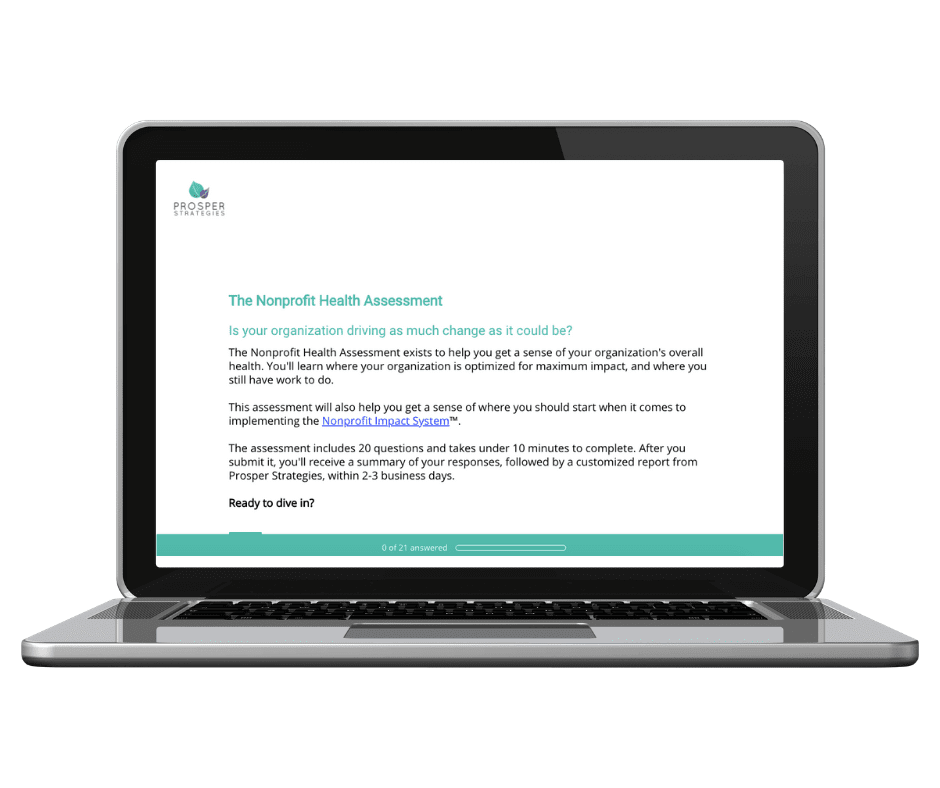The most successful nonprofits all have one thing in common: sound, actionable strategies. We’re unpacking the four most important strategies your organization needs, what each entails, and how to ensure yours are actionable.
Nonprofit Strategic Plan
The first and most important strategy your organization needs is its strategic plan. This plan is grounded in your nonprofit’s mission, vision, and values, and details your most important goals and objectives. It’s created following an assessment of your nonprofit’s ecosystem, strengths, weaknesses, opportunities, and threats, and with the input of stakeholders. Informed by these assessments, your strategic plan outlines your nonprofit’s most important goals and your roadmap for achieving them. To ensure your plan is visionary, yet also attainable, we recommend adopting a three-year vision, while detailing out your goals and objectives for the next year in pursuit of that vision.
[bctt tweet=”The first and most important strategy your organization needs is its strategic plan. This plan is grounded in your nonprofit’s mission, vision, and values, and details your most important goals and objectives.” username=”ProsperStrat”]Typically, your nonprofit strategic plan will include:
- Your mission, vision and values
- A summary of your nonprofit
- Your organization’s situation analysis along with your near-term vision
- Your organization-wide goals and objectives as well as your business goals and objectives
Accountability is key to a successful nonprofit strategic plan, which is why every goal and objective should be owned by an individual within your organization.
Nonprofit Programmatic Strategy
Your program planning process should be closely aligned to your nonprofit’s strategic planning process, since your programs are ultimately how you’re going to reach many of the goals outlined in your strategic plan. In fact, some organizations include their program plan within their strategic plan.
When building your program strategies, review other organizations in your area that provide similar services, so you know how what you offer is similar or different. Also, identify all of your nonprofit program collaborators, these are the other organizations you work with to support your clients.
For each one of your nonprofit’s programs, your strategy should detail:
- A high-level program description
- Your program target audiences, who it serves
- Your program’s geography, where you serve them
- Program comparators (other similar programs in your space)
- Program collaborators
It can also be helpful to articulate the people and geographies you don’t serve within your program plan, to ensure program specificity.
In addition to the nonprofit program overviews outlined above, you’ll want to detail anticipated program outcomes over a specific period of time; program goals for the next year; and your objectives for how you will measure progress toward those goals. To ensure your nonprofit program strategy is actionable, it should include program roadmaps that detail program activities along with assigned roles and responsibilities for your nonprofit’s team.
Nonprofit Fundraising Strategy
Your nonprofit fundraising strategy should be developed to support the goals laid out in your organization’s strategic plan. The cornerstone of a nonprofit fundraising strategy is your fundraising goal, which should be set for an annual fund or a specific campaign duration. The elements of your fundraising plan should include:
- Your campaign goal, which can be based on past nonprofit fundraising performance as well as a feasibility study
- A table of gifts, which outlines the number of prospects needed at each giving level to achieve the campaign goal
- Donor prospects, such as individuals, foundations and corporations
- Activities, events and campaigns you’ll deploy to reach your nonprofit donor prospects
To ensure the success of your nonprofit’s fundraising strategy, your plan should also detail campaign baselines, success metrics, a calendar or activities and clear roles and responsibilities for your nonprofit’s team members.
Nonprofit Marketing Strategy
Just as your nonprofit fundraising plan supports your strategic plan, so does your organization’s marketing strategy. With clear organization-wide goals and fundraising goals, your marketing strategy should follow naturally and include:
- Marketing goals and supporting objectives
- Stakeholder profiles, personified profiles of your organization’s most important audiences
- Tactics you’ll use to reach those stakeholders
- A marketing calendar
As with your other plans, roles and responsibilities should be defined in your marketing plan, and it should also include campaign baselines as well as success metrics.
There you have it – your nonprofit’s four most important strategies in a nutshell.
Want to see how your strategies compare?
The Nonprofit Health Assessment is a simple 20-question survey that will help you get a sense of your nonprofit’s overall health by analyzing all the key 
